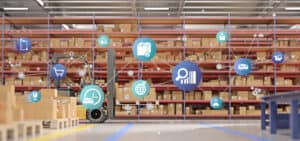
The integration of IoT devices and their real-time data into transportation services offers unprecedented visibility and control over the supply chain.
During and after the pandemic, supply chain woes became so common that the phrase “supply chain crisis” entered the household lexicon. The crisis peaked in 2021, with over 11,000 reported disruptions, up from 3,700 in 2019 and 6,192 in 2020. Thanks to pandemic-related delays, a lack of reliable labor, and unpredictable traffic patterns, combined with unprecedented peaks and troughs in consumer demand, it was a tough situation for transportation services.
One of the most troubling issues I commonly heard about was a lack of visibility into the overall supply chain. This has led to a lot of missed opportunities. Imagine a retail company launches a new product, and due to unexpectedly high demand, inventory levels quickly deplete. This leads to product shortages in stores and online. Everyone loses in this scenario. The retail store loses out on potential revenue. The store might develop trust issues with the transportation service. Consumers lose faith in the retailer.
Issues like that are more common now than ever. Though there’s no such thing as a foolproof resolution to supply chain issues, many transportation services have invested in real-time visibility metrics to get more insight into how goods move. Here are a few strategies for optimizing transportation services with real-time visibility.
Make everything smart
First, let’s talk about how smart technology can help give you more visibility into transportation services. Nowadays, it’s common to hear the term Internet of Things (IoT) thrown around. In terms of transportation services, IoT means that every component of the supply chain is affixed with some kind of tracker. IoT devices such as GPS trackers, sensors, and radio-frequency identification (RFID) tags can gather real-time data on shipments, vehicles, and inventory. These trackers provide real-time insights into the location, condition, and status of goods throughout the transportation process, enabling better visibility and proactive decision-making.
For example, consider a scenario in which your transportation service is in charge of delivering fresh produce from farms to retail stores. Obviously, freshness is key. Nobody would be happy about spoiled milk or wilted lettuce.
IoT trackers and sensors can also track temperature and humidity levels, feeding the info back to your centralized system. And if the sensors detect any deviations from the optimal temperature range, the system triggers an alert, notifying the transportation service immediately. You can take immediate action to fix the problem, like rerouting the shipment to a different vehicle or quickly calling a professional mechanic to address whatever mechanical issue may be causing the problem.
IoT devices in transportation services go beyond monitoring environmental conditions. GPS trackers can help optimize delivery routes – think Google Maps, but they are really granular. By continuously gathering real-time location data, GPS trackers let transportation services create optimized delivery routes. RFID tags provide unique identification information that can be wirelessly scanned and tracked. When RFID tags are attached to individual products or shipping containers, transport services can more easily manage their inventory as goods move through the supply chain.
Before real-time analytics, the end link of this supply chain would have been the unhappy recipient of some less-than-fresh goods. Now, the integration of IoT devices in transportation services has offered unprecedented visibility and control over the supply chain.
It’s worth pointing out that these strategies introduce additional challenges to be aware of. For example, when everything is connected to the internet, everything is hackable, which cybersecurity experts believe is a real risk for IoT-connected supply chains. In addition to that, all those smart devices will have to be maintained, serviced, and replaced regularly. These aren’t deal-breakers, but they are worth keeping in mind if you decide to incorporate this technology into your transportation service.
See also: Using Fuzzy Logic and AI to Improve Supply Chain Efficiency
Inventory management systems
IoT trackers help you keep a real-time eye on your goods on the go, but there’s also a lot you can do to maintain visibility in your warehouse right at home. Let’s go back to my earlier example with the unhappy retailer who experienced a surge in demand only to be unable to fulfill all the orders placed. Investing in a reliable warehouse inventory management system is one way to use real-time insights to prevent that kind of issue.
A warehouse inventory management system is like a digital assistant for your warehouses. It’s a platform that contains information on your inventory levels and locations, all in real time, using automated data capture. Again, you can rely on RFID tags or barcode scanning to know exactly when a product is received, picked, packed, or shipped. This means you always know how much stock you have and where it’s located, so you can avoid disappointing customers by running out of products.
The system also helps you fulfill orders efficiently. When a customer places an order, the system can prioritize it based on available inventory, where that inventory is located, and other factors. This helps your warehouse staff quickly locate the right products, pack them up, and get them ready for shipping.
Another benefit of the inventory management system is the ability to share real-time inventory data with your suppliers and retail partners. When your partners are in the loop about your inventory levels, you can work together more effectively. This collaboration ensures that everyone is on the same page, reducing supply chain disruptions and improving overall efficiency.
Before having access to real-time inventory management analytics, the retailer in our example struggled to keep up with sudden increases in demand. However, with a reliable warehouse inventory management system providing real-time insights, the retailer can more accurately track inventory levels, monitor sales trends, and adjust procurement and restocking strategies accordingly. If the retailer notices a surge in demand for a specific product, it can quickly replenish stock to meet customer needs, ensuring there’s enough inventory available.
Predictive models
Until now, we’ve discussed ways to track goods as they move through links in the supply chain, as well as manage inventory levels in real time. But we can do a step better than real-time – we can move beyond the “current” and into the “future.”
Some particular advanced management systems use statistical models like time series analysis or machine learning algorithms to forecast demand. The primary goal is to make accurate predictions based on historical data and patterns. These algorithms are fed historical data patterns and make predictions based on those patterns.
For example, a transportation service might use a machine learning algorithm to incorporate data such as customer demographics, product categories, or location. The model would then predict purchase trends, helping the transportation service know what to expect in terms of customer demand in the future.
These models are not without their challenges. They can be expensive, and you’ll need to hire a data scientist to build and maintain these models, as well as explain the results to you. These challenges are certainly surmountable, but it’s worth understanding that these models don’t build themselves.
Final thoughts
It’s been a grueling last couple of years for transportation services. We’ve weathered a global pandemic, severe weather events, unpredictable consumer purchasing behavior, deficits in key goods, a lack of reliable labor, and more.
I won’t go so far as to say real-time visibility is a panacea for these woes. The supply chain crisis is too complex for that. But more visibility into stock levels, fleets, and consumer behavior in real-time is always beneficial for transportation services, whether you’re tracking goods, monitoring your stock levels, or projecting your sales into the future.




























